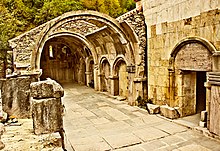Wahanawank
The monastery Wahanawank ( Armenian Վահանավանք ) is a former convent of the Armenian Apostolic Church in the south Armenian province of Syunik . The origins of the monastery go back to the 10th century. In the 11th century the monastery experienced its heyday. After that, it lost its importance and was abandoned in the 14th century. Today it is mostly a ruin. Parts of the monastery were rebuilt.
location
The monastery, founded at the beginning of the 10th century, is located about five kilometers west of Kapan in a forest area on the slopes of Mount Tigranasar high above the right bank of the Voghdschi river .
Building description
In the Middle Ages, the monastery complex was surrounded in the south, north and west by a wall made of rubble stones.
The main church Grigor Lusavorich is a cross- domed church made of local reddish basalt. The main entrance is in the south. There is another entrance to the west.
The Gawit is built in front of the church to the west. It has a rectangular floor plan. The roof is supported by three massive horseshoe-shaped arches. During an earthquake, the central arch collapsed, causing massive damage to the building. The entrance to the vestibule was on the south. Inside there is a frieze of floral and geometric patterns.
In the 140 square meter arcades that surround the church and Gawit, many tombstones with inscriptions from the tenth and eleventh centuries remain, including the tombs of the kings Smbat II, Grigor I, the queens Sophia and Dinar, the princes Ashot Jevanshir and Khaghbak and Vahan Nakhashinogh (tenth century), Princess Khuchesh (tenth century), Prince Kyurikid (eleventh century), and military leader Gevorg Pahlevuli (1101). In addition, an inscription was found in the building that mentions the year 1046. It is unclear whether this is the year of construction.
The simple two-story church Surb Astvatsatsin is a comparatively small mausoleum . It leans against the mountain in the west and stands on a vault made of quarry stone. Surb Astvatsatsin , like all structures in Wahanawank, was tiled. An inscription was found in the porch of the church, on which the name of Catholicos Stepanos Orbelian is mentioned.
The refectory was almost completely destroyed. It was rediscovered during the excavations.
To the southeast of the monastery there is a large burial ground that is dated to the end of the 2nd millennium BC.
history
According to the medieval historian and metropolitan of Sjunik , Stepanos Orbelian ( Armenian Ստեփանոս Օրբելյան ; approx. 1250-1305) the monastery was founded by Vahan, the son of the Syunite prince Dzagik, and then named after him. According to this, Vahan became a monk in order to free himself from the devil . Then he gathered 100 like-minded people around him and from 911 left the church Grigor Lusavorich ( Gregory the Illuminator , also Gregory the Illuminator ( Armenian Գրիգոր Լուսաւորիչ , translit. Grigor Lusavorich , ancient Greek Γρηγόριος Φωστήρ Gregorios Phoster or Φω ) τιτσ ). Vahan was buried in the monastery. After his death, his nephew, who was also called Vahan and had been trained in the monastery, continued the construction work on the monastery. Under his aegis the Gawit , a refectory and a portico were built. Later Vahan became Metropolitan of Sjunik and Katholikos .
In the 11th century the monastery became the religious center of the Syunik kings. The church Surb Astvatsatsin (( Armenian Սուրբ Աստվածածին , "Holy Mother of God "), western Armenian Surp Asdwadsadsin , other romanization Surp Astvatsatsin, Surb Astuacacin, Surb Astwazazin ) left Shahandukht, the Queen of Syunik, and her sister Kata in 1086 in the immediate vicinity of the Build the main church as a burial place for their family. Several kings, princes and high-ranking members of the clergy of Syunik and Aghvank were buried there.
In the 12th century invaders conquered the kingdom of Syunik. The monastery then lost its importance. It has been abandoned and in ruins since the 14th century.
In 1966 excavations were carried out at the monastery for the first time. Reconstruction of the area began in 1969 under the direction of the Armenian architect Arthur Meschian. In the years 2006–2009 the arcades were partially rebuilt and the church of Grigor Lusavorich and the Gawit restored.
Web links
Individual evidence
- ↑ a b c d e f g h Vahanavank, Syunik Region, Armenia. World Building Directory, accessed November 9, 2017 .
- ↑ a b c d e f g h i j Vahanavank Monastery. Armeniapedia.org, accessed November 9, 2017 .
Coordinates: 39 ° 13 ′ 4 ″ N , 46 ° 19 ′ 55 ″ E



